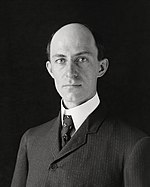Wilbur and Orville Wright
| The Wright brothers | |
|---|---|
| Nationality | American |
| Known for | inventing, building, and flying the world's first successful airplane |
| Orville Wright | |
| Born |
August 19, 1871 Dayton, Ohio |
| Died | January 30, 1948 (aged 76) Dayton, Ohio |
| Education | 3 years high school |
| Occupation | Printer/publisher, bicycle retailer/builder, airplane inventor/builder, pilot trainer |
| Wilbur Wright | |
| Born |
April 16, 1867 Millville, Indiana |
| Died | May 30, 1912 (aged 45) Dayton, Ohio |
| Education | 4 years high school |
| Occupation | Editor, bicycle retailer/builder, airplane inventor/builder, pilot trainer |
The Wright brothers, Orville (August 19, 1871 – January 30, 1948) and Wilbur (April 16, 1867 – May 30, 1912), were two American engineers, aviators, inventors, and aviation pioneers who are generally credited with inventing, building, and flying the world's first successful airplane. They made the first controlled, sustained flight of a powered, heavier-than-air aircraft on December 17, 1903, four miles south of Kitty Hawk, North Carolina. In 1904–05 the brothers developed their flying machine into the first practical fixed-wing aircraft. Although not the first to build and fly experimental aircraft, the Wright brothers were the first to invent aircraft controls that made fixed-wing powered flight possible.
The brothers' fundamental breakthrough was their invention of three-axis control, which enabled the pilot to steer the aircraft effectively and to maintain its equilibrium. This method became and remains standard on fixed-wing aircraft of all kinds. From the beginning of their aeronautical work, the Wright brothers focused on developing a reliable method of pilot control as the key to solving "the flying problem". This approach differed significantly from other experimenters of the time who put more emphasis on developing powerful engines. Using a small homebuilt wind tunnel, the Wrights also collected more accurate data than any before, enabling them to design and build wings and propellers that were more efficient than any before. Their first U.S. patent, 821,393, did not claim invention of a flying machine, but rather, the invention of a system of aerodynamic control that manipulated a flying machine's surfaces.
They gained the mechanical skills essential for their success by working for years in their shop with printing presses, bicycles, motors, and other machinery. Their work with bicycles in particular influenced their belief that an unstable vehicle like a flying machine could be controlled and balanced with practice. From 1900 until their first powered flights in late 1903, they conducted extensive glider tests that also developed their skills as pilots. Their bicycle shop employee Charlie Taylor became an important part of the team, building their first airplane engine in close collaboration with the brothers.
...
Wikipedia


